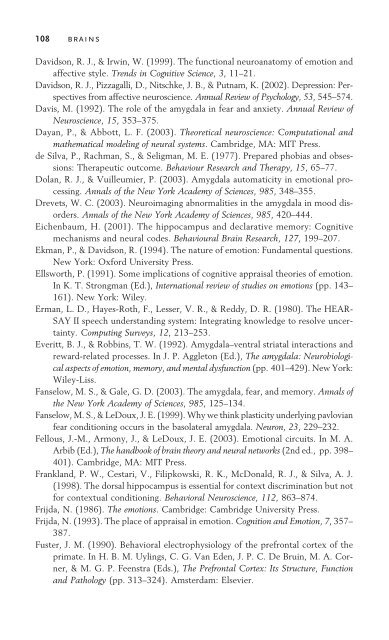Who Needs Emotions? The Brain Meets the Robot
Who Needs Emotions? The Brain Meets the Robot
Who Needs Emotions? The Brain Meets the Robot
Create successful ePaper yourself
Turn your PDF publications into a flip-book with our unique Google optimized e-Paper software.
108 brains<br />
Davidson, R. J., & Irwin, W. (1999). <strong>The</strong> functional neuroanatomy of emotion and<br />
affective style. Trends in Cognitive Science, 3, 11–21.<br />
Davidson, R. J., Pizzagalli, D., Nitschke, J. B., & Putnam, K. (2002). Depression: Perspectives<br />
from affective neuroscience. Annual Review of Psychology, 53, 545–574.<br />
Davis, M. (1992). <strong>The</strong> role of <strong>the</strong> amygdala in fear and anxiety. Annual Review of<br />
Neuroscience, 15, 353–375.<br />
Dayan, P., & Abbott, L. F. (2003). <strong>The</strong>oretical neuroscience: Computational and<br />
ma<strong>the</strong>matical modeling of neural systems. Cambridge, MA: MIT Press.<br />
de Silva, P., Rachman, S., & Seligman, M. E. (1977). Prepared phobias and obsessions:<br />
<strong>The</strong>rapeutic outcome. Behaviour Research and <strong>The</strong>rapy, 15, 65–77.<br />
Dolan, R. J., & Vuilleumier, P. (2003). Amygdala automaticity in emotional processing.<br />
Annals of <strong>the</strong> New York Academy of Sciences, 985, 348–355.<br />
Drevets, W. C. (2003). Neuroimaging abnormalities in <strong>the</strong> amygdala in mood disorders.<br />
Annals of <strong>the</strong> New York Academy of Sciences, 985, 420–444.<br />
Eichenbaum, H. (2001). <strong>The</strong> hippocampus and declarative memory: Cognitive<br />
mechanisms and neural codes. Behavioural <strong>Brain</strong> Research, 127, 199–207.<br />
Ekman, P., & Davidson, R. (1994). <strong>The</strong> nature of emotion: Fundamental questions.<br />
New York: Oxford University Press.<br />
Ellsworth, P. (1991). Some implications of cognitive appraisal <strong>the</strong>ories of emotion.<br />
In K. T. Strongman (Ed.), International review of studies on emotions (pp. 143–<br />
161). New York: Wiley.<br />
Erman, L. D., Hayes-Roth, F., Lesser, V. R., & Reddy, D. R. (1980). <strong>The</strong> HEAR-<br />
SAY II speech understanding system: Integrating knowledge to resolve uncertainty.<br />
Computing Surveys, 12, 213–253.<br />
Everitt, B. J., & Robbins, T. W. (1992). Amygdala–ventral striatal interactions and<br />
reward-related processes. In J. P. Aggleton (Ed.), <strong>The</strong> amygdala: Neurobiological<br />
aspects of emotion, memory, and mental dysfunction (pp. 401–429). New York:<br />
Wiley-Liss.<br />
Fanselow, M. S., & Gale, G. D. (2003). <strong>The</strong> amygdala, fear, and memory. Annals of<br />
<strong>the</strong> New York Academy of Sciences, 985, 125–134.<br />
Fanselow, M. S., & LeDoux, J. E. (1999). Why we think plasticity underlying pavlovian<br />
fear conditioning occurs in <strong>the</strong> basolateral amygdala. Neuron, 23, 229–232.<br />
Fellous, J.-M., Armony, J., & LeDoux, J. E. (2003). Emotional circuits. In M. A.<br />
Arbib (Ed.), <strong>The</strong> handbook of brain <strong>the</strong>ory and neural networks (2nd ed., pp. 398–<br />
401). Cambridge, MA: MIT Press.<br />
Frankland, P. W., Cestari, V., Filipkowski, R. K., McDonald, R. J., & Silva, A. J.<br />
(1998). <strong>The</strong> dorsal hippocampus is essential for context discrimination but not<br />
for contextual conditioning. Behavioral Neuroscience, 112, 863–874.<br />
Frijda, N. (1986). <strong>The</strong> emotions. Cambridge: Cambridge University Press.<br />
Frijda, N. (1993). <strong>The</strong> place of appraisal in emotion. Cognition and Emotion, 7, 357–<br />
387.<br />
Fuster, J. M. (1990). Behavioral electrophysiology of <strong>the</strong> prefrontal cortex of <strong>the</strong><br />
primate. In H. B. M. Uylings, C. G. Van Eden, J. P. C. De Bruin, M. A. Corner,<br />
& M. G. P. Feenstra (Eds.), <strong>The</strong> Prefrontal Cortex: Its Structure, Function<br />
and Pathology (pp. 313–324). Amsterdam: Elsevier.






